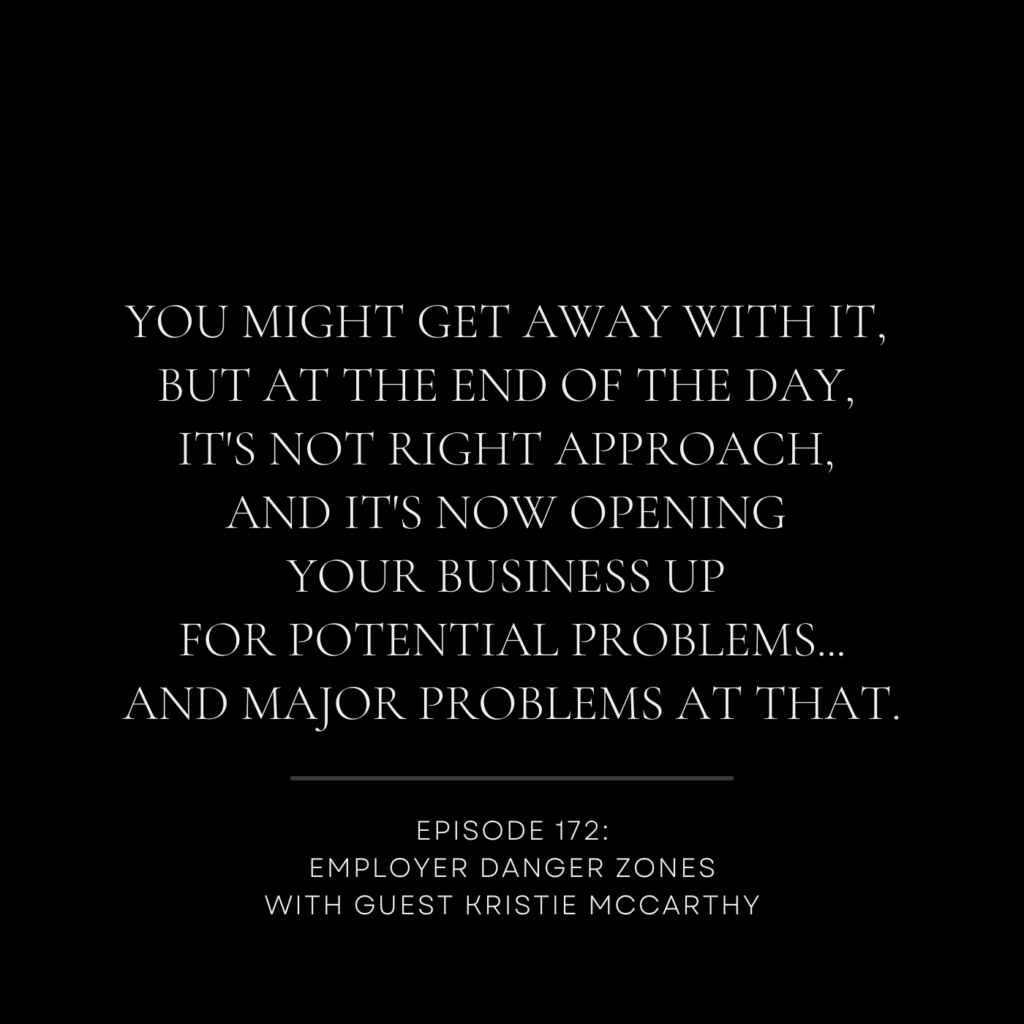It’s back to school, listener! Back to business school that is, as today we sit down with human resources coach and consultant and small business owner, Kristie McCarthy of Bridge Business Resources. You will definitely want to have a pen and paper ready as you listen through this episode and hear Kristie’s advice on protecting yourself and your team members from common struggles and errors that can occur when employing a team.

With over 20 years of experience in HR, Kristie’s goal is to help you bridge the gaps that can happen in the people side of operating a small business. She understands that business owners can be exceptional in their craft and kick ass at making sales, marketing, etc. But when it comes to growing a team, we as business owners can have major blindspots in legal and tax requirements that come along with employment. Even with the best of intentions, there are pitfalls employers face when managing a team, and Kristie’s mission at Bridge is to help you identify and proactively plan for the human side of your business.
In today’s episode, Kristie shares the 6 employer danger zones she commonly sees with her clients and how you can take action today to address these areas in your own business.








Danger Zones to Watch Out For
- Protected Classes of Employees: Age, race, ethnicity, gender/orientation, religion, marital/family status, disabilities/genetics…applicants, employees, and former employees cannot be subjected to harassment, discrimination, or adverse employment decisions based on these categories. Furthermore, they must be protected from retaliation should they file a complaint and/or lawsuit alleging discrimination or harassment. It is critical as employers to be aware of how these issues come into play in hiring/dismissal (sometimes inadvertently in conversation!). It is critical to have company policies outlined in an employee handbook and ensure that employees, supervisors, and managers are trained in these areas regularly.
- Classifying Employees: One of the most common mistakes employers can make is misclassifying employees, ie: is this person an independent contractor or a W-2 employee? A few questions to ask if you are wondering this on behalf of your team: Did the worker complete an application for the job? Does your business control how the work is completed? Does your business provide the tools for completing said work? Does the worker only perform the services for your business? Is the work being performed a key aspect of your business? If you answered yes to these questions, the worker likely should be considered an employee and placed on payroll.
- Payroll & Time Tracking: Nearly all employers must comply with FLSA regulations, which in part includes maintaining accurate timecard records, ensuring all employees are paid for all worked time, paying for overtime hours, etc. For salaried employees, employers need to be aware of and follow a separate set of rules and regulations including how PTO is assessed an applied for staffers.
- Employee Safety & Reporting: Outlining safety policies in a manual or handbook and ensuring that employees are trained on these protects everyone in the organization. For employee reporting, ensure that you don’t offer rewards that incentivize employees NOT to report injuries and that injured employees are protected from retaliation. In addition, employers with over 10 employees are required to maintain an OSHA 300 log each year and said logs must be preserved for 5 years.
- Terminating Employees: Thinking of letting a team member go? There are a few steps you must take to ensure that you and your employees are protected. First, plan ahead. Do not make termination decisions in the heat of the moment! Prior to termination, make sure all employees sign acknowledgement of the at-will arrangement (this varies state by state) if your state falls under at-will employment and provide opportunities to improve if you have a staffer who is falling short of goals/position requirements. If termination becomes necessary, be sure to have documentation prepared, a plan in place for dismissal, and even a script to guide you through the termination conversation.
- Protecting your Business: Employment lawsuits have increased over 400% in the last 20 years, and more than 40% of lawsuits filed come against employers with fewer than 100 employees. Even if you are a small business, you need to take steps to protect yourself and your team members, including following the above guidelines, developing and using an employee handbook with hires, training your staff members, holding insurance for your company, and seeking professional advice if and when you need it.

More About Kristie and her business, Bridge Business Resources
Whether you are a small business owner, trying to do it all yourself, or a leader in a larger organization trying to prepare for the next step, it is difficult to do it all. There are inevitably gaps…whether it is in communication, in what you can offer your employees, or in how prepared you are for the growth you hope to achieve.Bridge Business Resources is here to fill those gaps, take work off your plate, and allow you to spend time focused on what you do best. Bridge helps you with consulting, coaching, and done for you services including payroll processing, human resources activities, and more. Visit the Bridge Business Resources website or connect with Bridge on Facebook and LinkedIn to see how Kristie can help you thrive.

Be the first to comment